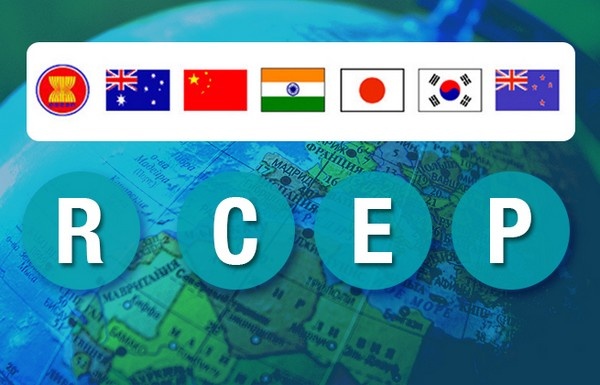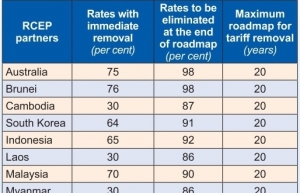Long-term gains on horizon for Vietnam via RCEP
Luong Van Khoi, director of the National Centre for Socio-economic Information and Forecast (NCIF) under the Ministry of Planning and Investment, said that under fresh international reports on impacts of the partnership (RCEP), the deal will have positive impacts on its member economies.
The RCEP was signed in November 2020 by the 10 ASEAN member states and the bloc’s partners of China, Japan, South Korea, Australia, and New Zealand. The deal took effect at the start of 2022.
 |
| Long-term gains on horizon for Vietnam via RCEP, source:baodautu.vn |
“It is calculated that by 2030, the RCEP will increase incomes in the economies by 0.6 per cent, tantamount to $245 billion, with an additional 2.8 million jobs to be created,” Khoi said at last week’s launch in Hanoi of a report on how the RCEP can shape supply chains in Vietnam. The report was prepared by the NCIF and Germany’s Konrad-Adenauer-Stiftung Vietnam.
For Vietnam, some studies have shown that the country is expected to benefit from the RCEP. For example, the World Bank said that the deal will enable Vietnam’s GDP to increase by an additional 4.9 per cent and exports to rise by an additional 11.4 per cent by 2030.
Besides commitments as a traditional free trade agreement (FTA), the RCEP also embraces other commitments on e-commerce, telecommunications, competition, small- and medium-sized enterprises, and public procurement. “However, one of the most important points in the RCEP is that it offers harmonised and cumulative rules of origin (ROO) for the region, ushering in many opportunities for intra-bloc exports,” Khoi said.
Nguyen Thi Thu Trang, director of the Centre for WTO and International Trade under the Vietnam Chamber of Commerce and Industry, once said that while implementing projects in Vietnam, investors would need to import products for production and then exports abroad, including to RCEP member states.
“One of the most noticeable points in the RCEP is that this agreement has been designed to reduce costs and time for businesspeople, and the deal allows them to export goods to each member market without having to meet that market’s own requirements,” Trang said. “This will help investors increase investment in Vietnam.”
For example, for the Comprehensive and Progressive Agreement for Trans-Pacific Partnership (CPTPP), businesses from Vietnam will find it difficult to take advantage of tariff incentives for their garments and textiles due to tough requirements in ROO applied commonly within the bloc, as almost all materials Vietnam need are imported from China – which is not a CPTPP member, Trang said. “However, for the RCEP, to which China is a member, the burden of import costs for input materials will be reduced thanks to tariff incentives.”
What is more, the RCEP will greatly benefit Vietnam’s many key export items including garments and textiles, agricultural products, and aquatic products exported to the member markets like Japan and South Korea.
Specifically, under the Vietnam-Japan FTA and ASEAN-Japan Comprehensive Economic Partnership, and under the Korea-Vietnam FTA and the ASEAN-Korea FTA, garments and textiles are subject to meet 2-phase ROO, meaning cloth must be produced within ASEAN or Japan or South Korea before receiving incentives. Meanwhile, under the RCEP, Vietnam can import cloth from everywhere and conduct production in its territory, and the products can enjoy tariff incentives when exported to Japan or South Korea.
Similarly for aquatic products, the aforementioned Japan and ASEAN deals require ROO in Vietnam, but the RCEP allows the country to import breeds from anywhere or source the breeds from inside its territory, and all export products are still entitled to tariff incentives.
According to the Centre for WTO and International Trade, in 2021, Vietnam earned an export turnover of $132.3 billion from RCEP markets, up 16 per cent on-year, and spent $238.5 billion on imports from these economies – meaning a $106.18 billion trade deficit.
“Thus, the RCEP is expected to help Vietnam attract more investments from the member states and enable domestic companies to seek more partners,” Trang said.
She added that there is little worry of a big trade deficit as Vietnam’s commitments on import tariffs are almost the same as other FTAs, and the demand for Vietnamese goods from those markets have been rising. Meanwhile, almost all products imported into Vietnam are used for production and then re-exported to RCEP countries and the wider world.
According to the NCIF’s prediction, the impact of ROO on reshaping supply chains will focus on industry groups of electronics, automotives, and textiles in the medium- and long-term because of their large proportion of exports and imports.
Trinh Thi Thu Hien, manager of Goods Origin at the Export and Import Department under the Ministry of Industry and Trade, said, “The application of combined ROO will help Vietnam import electronic components and materials from any RCEP country to continue processing or manufacturing finished products while still enjoying tax incentives when exporting these products to other RCEP menbers.”
Regarding the investment promotion, according to NCIF director Tran Toan Thang, Vietnam currently focuses mainly on downstream processing and assembling such products as electronics, automotive and garments or low- or medium-tech finished products like textiles.
“Thus, the RCEP also creates opportunities for Vietnam to increase productivity as well as overcome the state of simple production by increasing specialisation in the industries where the country has advantages, thereby attracting more foreign enterprises,” Thang said.
 | Decades of benefits becoming clear through expansive RCEP While offering favourable conditions for the rule of origin and expanding exports, the Regional Comprehensive Economic Partnership will enable Vietnam to attract more investment than other free trade agreements as many of the country’s largest foreign investors are from the deal’s member economies. |
 | Indonesian parliament adopts RCEP Indonesia’s parliament on August 30 passed a law cementing the country’s membership of the Regional Comprehensive Economic Partnership (RCEP), making it the latest Southeast Asian nation to join the world’s biggest trade bloc. |
 | RCEP among most-promising trade agreements for Vietnam Vietnam is expected to reap the most investment and trade benefits from the Regional Comprehensive Economic Partnership (RCEP) when compared to many other trade pacts, as most of the country’s largest foreign investors are from the deal’s member economies. |
What the stars mean:
★ Poor ★ ★ Promising ★★★ Good ★★★★ Very good ★★★★★ Exceptional
 Tag:
Tag:
Related Contents
Latest News
More News
- Strengthening supply chains through trade promotions and customs reform (December 24, 2025 | 14:00)
- PM orders investment model for North–South high-speed rail (December 22, 2025 | 17:43)
- LS Eco Energy to invest in Vietnam rare earth sector (December 22, 2025 | 17:31)
- Government moves to establish International Financial Centre (December 21, 2025 | 21:00)
- Vietnam's IFC to target global investment flows (December 21, 2025 | 18:00)
- Two national hospitals expand capacity with new facilities (December 20, 2025 | 09:00)
- Ha Tinh breaks ground on major Vingroup industrial and energy projects (December 19, 2025 | 18:24)
- EVN launches major power infrastructure projects nationwide (December 19, 2025 | 18:17)
- VAL inaugurates second production line to meet domestic animal feed demand (December 19, 2025 | 16:37)
- Sun Group pioneers urban tram system in Phu Quoc (December 19, 2025 | 15:00)
























 Mobile Version
Mobile Version